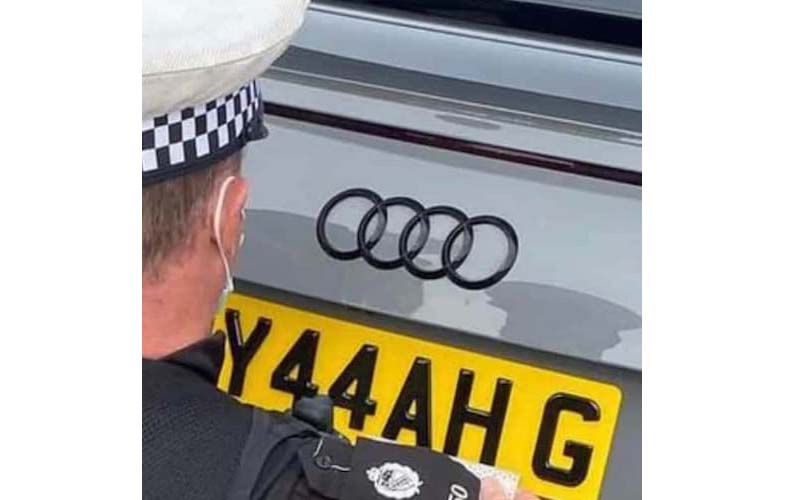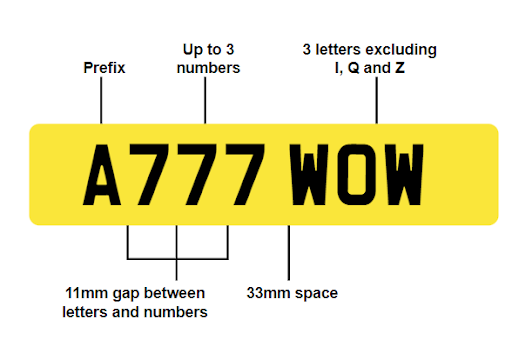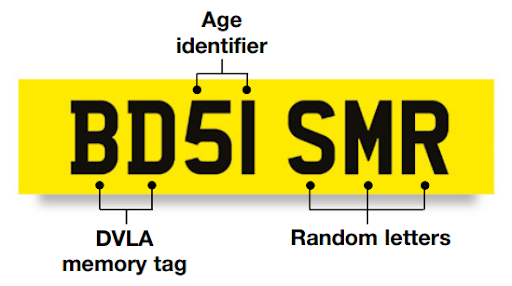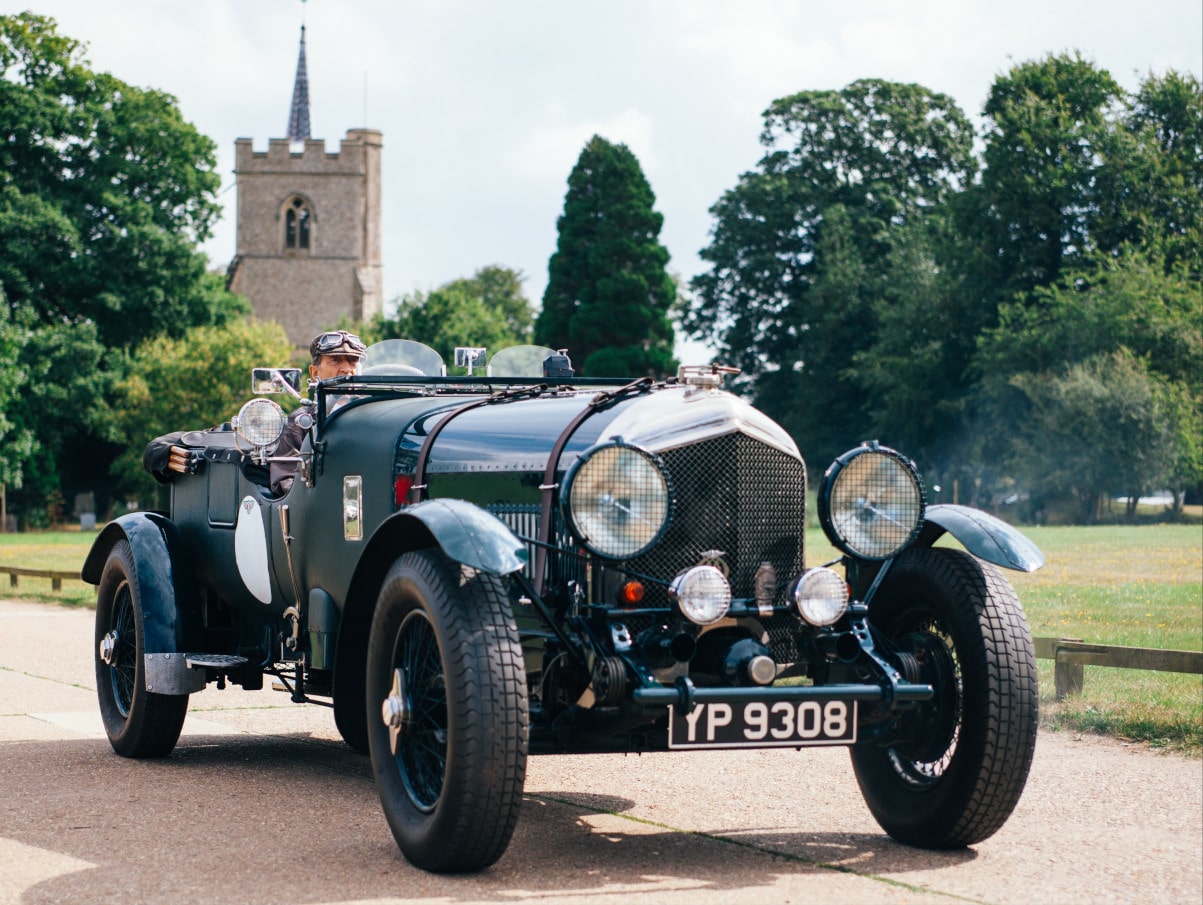Are your UK number plates legal?
In the United Kingdom, displaying number plates on your vehicle is a legal requirement. The purpose of the number plate is to identify the vehicle and its owner, and to help enforce road traffic laws.
Every day we have clients ask us if they can mis-space or alter their number plates to their liking and wish to further customise their Private Plates so that they have more meaning to them.
We wanted to put together this handy guide of answers to the most-asked questions on this subject to help you understand the do's and don'ts when it comes to displaying a vehicle number plate on the UK roads.

What regulations must my plates comply with?
There are strict rules and regulations governing the design and display of UK number plates that are to be used on the public highway. Failure to comply with these rules can result in fines of up to £1000 and your registration mark may be permanently confiscated.

- Motorists must display number plates on the front and rear of their vehicle or just the rear, in the case of motorbikes and motorbike-derived tricycles.
- Motorbikes must display their rear registration mark over two lines
- You must display single shade black characters on a white background (front plate) & black characters on a yellow background (rear plate) unless you have a historic vehicle (*see below)
- The characters must be made of single-shade, non-reflective, solid black material and the background must be reflective. Characters must not be printed to look like carbon fibre or 3D ‘effect’ with highlight lines or any shading.
- Number plates must be clean and clearly visible at all times.
- The characters on the number plate must also be in a specific font and size. The current standard font for number plates in the UK is called ‘Charles Wright’. They must be 79mm tall and 50mm wide (except number 1 or the letter I), with a stroke width of 14mm, except for motorcycles when the character sizes are 64mm tall and 44mm wide. There must always be a minimum plain border of (minimum sized) 11mm width around all the characters.
- Border lines of any colour are not permitted
- The space between the characters and the space between the groups of characters, must also be within specific limits. These are 11mm between each character (letter or number) with the space between the age identifiers and the random numbers (two groupings) being 33mm. These spacings should not be larger or smaller.
- The number plate must be marked to show who supplied the number plate, who manufactured the plate and must show the British Standard approval number - This number is ‘BS AU 145e’ for plates fitted after 1 September 2021
- The plate must be plain with no background pattern
- You cannot rearrange or misrepresent the numbers and letters on a number plate to form names or words, so that they are hard to read. For example fixing bolts to change any of the letters or numbers.
- You may add certain left-hand-side flags (see below) but any other images including those that represent brands, sports clubs, cartoon characters, etc. are prohibited.
- You can’t use your registration number plates to make your vehicle appear younger than it actually is.
It is important to note that number plates must not be altered or modified in any way that could render them difficult to read or mislead other road users. This includes the use of non-standard fonts or stylised characters, the addition of symbols or graphics that are not part of the standard design and the application of tinted materials to darken the colour of the plate.


Can I legally modify my number plates so they stand out from the crowd?
There are several ways to legally make your number plates stand out:
- You can have 3D GEL and 4D solid black acrylic lettering but the former are prone to become detached from plates quite easily and so do not usually meet the required BS AU 145e manufacturing standards. Tip: Make sure that your number plates have the raised digits stuck over the usual printed registration mark, so that if a digit falls off your plates are still legal. More information on BS AU 145e manufacturing standards.
- Shortened number plates are legal in the UK but can only be made if your registration mark is less than 7 digits long. The spacing between the digits of 11mm between each character (letter or number) and 33mm between the age identifiers and the random numbers (two groupings) must be kept There must still be a sufficient border around the whole registration mark of 11mm minimum. Shortened plates must still meet the BS AU 145e manufacturing standards.
- Shaped number plates are legal in the UK but the spacing between the digits of 11mm between each character (letter or number) and 33mm between the age identifiers and the random numbers (two groupings) must be kept. There must also still be a sufficient border around the whole registration mark of 11 mm minimum. Shaped plates must still meet the BS AU 145e manufacturing standards.
- You can display one of the following flags with country-specific identifying letters on the left-hand side of the number plate but they cannot be more than 50mm wide: Union flag, Cross of St George, Cross of St Andrew, Red dragon of Wales.
- The letters, or national identifiers, you can have are:
- GREAT BRITAIN, Great Britain or GB
- UNITED KINGDOM, United Kingdom or UK
- ENGLAND, England, ENG or Eng
- SCOTLAND, Scotland, SCO or Sco
- CYMRU, Cymru, CYM or Cym
- WALES or Wales
Useful Tip: Vehicles which have both the letters ‘UK’ and the Union flag on their number plate do not need to display a separate UK sticker when travelling in the EU unless they are travelling to Spain, Malta or Cyprus. Please note: GB stickers or GB plates are no longer accepted as proof of nationality in Europe so separate UK stickers must be added to your vehicle if you are travelling there with GB plates.
- Zero emission vehicles (ZEVs) are permitted to display a green flash on the left hand side of the number plate.
- If you have a standard registration mark, you may wish to personalise your vehicle with a Private Number Plate. You can purchase one which is car specific OR you could choose one which is relevant to you. Plates4Less has a Smart Search tool to help you easily find the perfect match.
What are the most common illegal number plates?
The most common illegal number plate modification is spacing. Many people want to change the spacing so that their number plate better reads a word or name. People also commonly alter or modify the design of the characters on the plate (typeface) which also makes them illegal for use on the public highway.
Can you spot an illegal plate?
Historic Vehicle Number plates display laws
Vehicles manufactured before 1 January 1973 may display traditional ‘black and white’ number plates (for example, white, silver or grey characters on a black plate). From April 2020 vehicles manufactured before 1 January 1980 are also able to display traditional ‘black and white’ number plates but you must have applied to DVLA and be registered within the ‘historic vehicles’ tax class first.

Why should I comply with the rules and regulations for displaying a number plate?
There are penalties for failing to comply with the rules and regulations for displaying roadgoing number plates in the UK. If your number plate is deemed to be non-compliant, you may be issued with fines of up to £1000 and your registration mark may be permanently confiscated. In some cases, you may also be required to have the number plate replaced at your own cost.
How and where can I get number plates made to ensure that I am complying with the law?
To ensure that you are buying road legal number plates, you should always choose a DVLA registered number plate supplier (DVLA RNPS). By choosing a supplier who is not registered with the DVLA’s RNPS your plates may not meet government standards and therefore you may be at a higher risk of receiving a penalty. Please use the link to check if a supplier is registered with the DVLA:
https://www.gov.uk/number-plate-supplier
To get a set of new or Acrylic Number Plates you will need to supply proof that you own the rights to display the registration mark and proof of your name and address.
Documents that you can use to prove you own the rights to the registration are:
- V750 Certificate of Entitlement/ V778 Retention Document.
- eV948 Plating Certificate (this is issued by the DVLA once a transfer is completed using their digital service and is only valid for up to 3 days afterwards)
- V948 Number plate Authorisation Certificate issued by DVLA - non digital transfer
- V5C Registration Certificate (Logbook)
Latest articles

The Rise of the Hyper Plate
View article
New Government Number Plate Proposals Risk Fueling Illegal supply
View article
Private Number Plates: The Perfect Christmas Gift
View article